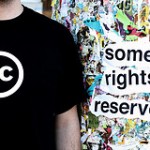Regardless of your personal opinions about copyright laws in Canada and the fair use of digital media, only media that is clearly licensed for reuse is permitted in SCIE 300. What does that mean? It means that you must not use any copyrighted music, sound effects, images, or film clips in your assignments unless you have written permission. This may sound harsh, but you still have a lot of options for incorporating images, music, and video into your work without dealing with copyright permissions.
Many people give their work a Creative Commons license. For example, the image used in the header of this blog has a Creative Commons license so it’s OK to use it here as long as attribution is given. There are a few different types of Creative Commons licenses so make sure you read the details. For instance, sometimes it’s OK to reuse an image only in it’s original form (i.e., no derivatives). That means using it as is. So, no cropping. In fact, no alterations of any kind. The safest thing to do is always provide the source of the content and a link back to the original, which has been done for both of the smaller images within this post.
To help you navigate through this, there is a page on the UBC Wiki called Free Stuff that summarizes where you can find suitable materials. For example, it’s possible to do flickr and Google searches that only return images licensed for reuse. Just use the advanced search for both of these and select a Creative Commons license in the licensing search options. In flickr, when you hover your mouse arrow over the license information, you get a definition of what each of the symbols mean. An equal sign means no derivatives. A dollar sign with a line through it means no commercial use.
In terms of audio content, the Free Music Archive, as the name suggests, is filled with music that you are free to download and reuse as long as you give credit to the creator. There is also a collection of creative commons sound effects, which doubles as a really hilarious way to waste time. Video is trickier. You will find some video on image sharing websites like flickr and Picasa, but not much. If you want to incorporate parts of a video that you find on YouTube into your own work, you must be certain that it’s OK to do so. Read the description and re-use information carefully. Many government or educational institutions allow their video content to be reused, but remember that you always have to give credit. Keep in mind that linking and embedding are always OK. Embedding a video from YouTube on the course blog, for example, is not creating a new copy of the video. It is essentially just a link to the original. However, downloading a YouTube video to your computer and the re-uploading it to the course blog is not recommended.
If you are ever unsure about whether you are allowed to reuse something, you can also send the creator a message (if a contact email is provided) asking them if it’s OK to use their stuff. Most of the time, especially for non-commercial uses, it will be OK and they will thank you for asking.
It might seem like this makes finding materials for your assignments more complicated. It doesn’t. The resources we have summarized here plus the wealth of information available online about Creative Commons, should help you. Remember that this information is relevant to your own work in this course and to any materials you may post online. When you create your podcast and video for SCIE 300, be sure to think about what sort of license you wish to give your work. Finally, please remember that YOU are responsible for making sure you use only appropriate materials and are liable for any misuse of copyrighted materials.


